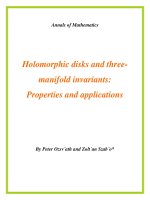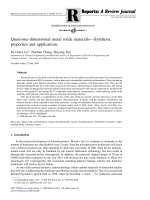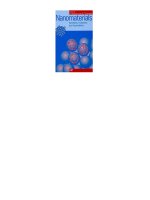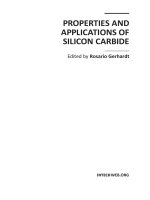Microemulsions properties and applications crc 2009
Bạn đang xem bản rút gọn của tài liệu. Xem và tải ngay bản đầy đủ của tài liệu tại đây (11.23 MB, 568 trang )
MICROEMULSIONS
Properties and Applications
89595_C000.indd i
11/10/2008 10:02:46 PM
SURFACTANT SCIENCE SERIES
FOUNDING EDITOR
MARTIN J. SCHICK
1918–1998
SERIES EDITOR
ARTHUR T. HUBBARD
Santa Barbara Science Project
Santa Barbara, California
ADVISORY BOARD
DANIEL BLANKSCHTEIN
Department of Chemical
Engineering
Massachusetts Institute of
Technology
Cambridge, Massachusetts
S. KARABORNI
Shell International Petroleum
Company Limited
London, England
CLARENCE MILLER
Department of Chemical
Engineering
Rice University
Houston, Texas
LISA B. QUENCER
The Dow Chemical Company
Midland, Michigan
DON RUBINGH
The Procter & Gamble Company
Cincinnati, Ohio
JOHN F. SCAMEHORN
Institute for Applied Surfactant
Research
University of Oklahoma
Norman, Oklahoma
BEREND SMIT
Shell International Oil Products B.V.
Amsterdam, The Netherlands
P. SOMASUNDARAN
Henry Krumb School of Mines
Columbia University
New York, New York
89595_C000.indd ii
ERIC W. KALER
Department of Chemical
Engineering
University of Delaware
Newark, Delaware
JOHN TEXTER
Strider Research Corporation
Rochester, New York
11/10/2008 10:02:46 PM
1. Nonionic Surfactants, edited by Martin J. Schick (see also Volumes 19,
23, and 60)
2. Solvent Properties of Surfactant Solutions, edited by Kozo Shinoda
(see Volume 55)
3. Surfactant Biodegradation, R. D. Swisher (see Volume 18)
4. Cationic Surfactants, edited by Eric Jungermann (see also Volumes 34,
37, and 53)
5. Detergency: Theory and Test Methods (in three parts), edited by
W. G. Cutler and R. C. Davis (see also Volume 20)
6. Emulsions and Emulsion Technology (in three parts), edited by
Kenneth J. Lissant
7. Anionic Surfactants (in two parts), edited by Warner M. Linfield
(see Volume 56)
8. Anionic Surfactants: Chemical Analysis, edited by John Cross
9. Stabilization of Colloidal Dispersions by Polymer Adsorption, Tatsuo Sato
and Richard Ruch
10. Anionic Surfactants: Biochemistry, Toxicology, Dermatology, edited by
Christian Gloxhuber (see Volume 43)
11. Anionic Surfactants: Physical Chemistry of Surfactant Action, edited by
E. H. Lucassen-Reynders
12. Amphoteric Surfactants, edited by B. R. Bluestein and Clifford L. Hilton
(see Volume 59)
13. Demulsification: Industrial Applications, Kenneth J. Lissant
14. Surfactants in Textile Processing, Arved Datyner
15. Electrical Phenomena at Interfaces: Fundamentals, Measurements,
and Applications, edited by Ayao Kitahara and Akira Watanabe
16. Surfactants in Cosmetics, edited by Martin M. Rieger (see Volume 68)
17. Interfacial Phenomena: Equilibrium and Dynamic Effects,
Clarence A. Miller and P. Neogi
18. Surfactant Biodegradation: Second Edition, Revised and Expanded,
R. D. Swisher
19. Nonionic Surfactants: Chemical Analysis, edited by John Cross
20. Detergency: Theory and Technology, edited by W. Gale Cutler
and Erik Kissa
21. Interfacial Phenomena in Apolar Media, edited by Hans-Friedrich Eicke
and Geoffrey D. Parfitt
22. Surfactant Solutions: New Methods of Investigation, edited by
Raoul Zana
23. Nonionic Surfactants: Physical Chemistry, edited by Martin J. Schick
24. Microemulsion Systems, edited by Henri L. Rosano and Marc Clausse
25. Biosurfactants and Biotechnology, edited by Naim Kosaric, W. L. Cairns,
and Neil C. C. Gray
26. Surfactants in Emerging Technologies, edited by Milton J. Rosen
27. Reagents in Mineral Technology, edited by P. Somasundaran
and Brij M. Moudgil
28. Surfactants in Chemical/Process Engineering, edited by Darsh T. Wasan,
Martin E. Ginn, and Dinesh O. Shah
29. Thin Liquid Films, edited by I. B. Ivanov
89595_C000.indd iii
11/10/2008 10:02:46 PM
30. Microemulsions and Related Systems: Formulation, Solvency, and
Physical Properties, edited by Maurice Bourrel and Robert S. Schechter
31. Crystallization and Polymorphism of Fats and Fatty Acids, edited by
Nissim Garti and Kiyotaka Sato
32. Interfacial Phenomena in Coal Technology, edited by Gregory D. Botsaris
and Yuli M. Glazman
33. Surfactant-Based Separation Processes, edited by John F. Scamehorn
and Jeffrey H. Harwell
34. Cationic Surfactants: Organic Chemistry, edited by James M. Richmond
35. Alkylene Oxides and Their Polymers, F. E. Bailey, Jr.,
and Joseph V. Koleske
36. Interfacial Phenomena in Petroleum Recovery, edited by
Norman R. Morrow
37. Cationic Surfactants: Physical Chemistry, edited by Donn N. Rubingh
and Paul M. Holland
38. Kinetics and Catalysis in Microheterogeneous Systems, edited by
M. Grätzel and K. Kalyanasundaram
39. Interfacial Phenomena in Biological Systems, edited by Max Bender
40. Analysis of Surfactants, Thomas M. Schmitt (see Volume 96)
41. Light Scattering by Liquid Surfaces and Complementary Techniques,
edited by Dominique Langevin
42. Polymeric Surfactants, Irja Piirma
43. Anionic Surfactants: Biochemistry, Toxicology, Dermatology,
Second Edition, Revised and Expanded, edited by Christian Gloxhuber
and Klaus Künstler
44. Organized Solutions: Surfactants in Science and Technology, edited by
Stig E. Friberg and Björn Lindman
45. Defoaming: Theory and Industrial Applications, edited by P. R. Garrett
46. Mixed Surfactant Systems, edited by Keizo Ogino and Masahiko Abe
47. Coagulation and Flocculation: Theory and Applications, edited by
Bohuslav Dobiás
48. Biosurfactants: Production Properties Applications, edited by
Naim Kosaric
49. Wettability, edited by John C. Berg
50. Fluorinated Surfactants: Synthesis Properties Applications, Erik Kissa
51. Surface and Colloid Chemistry in Advanced Ceramics Processing,
edited by Robert J. Pugh and Lennart Bergström
52. Technological Applications of Dispersions, edited by Robert B. McKay
53. Cationic Surfactants: Analytical and Biological Evaluation, edited by
John Cross and Edward J. Singer
54. Surfactants in Agrochemicals, Tharwat F. Tadros
55. Solubilization in Surfactant Aggregates, edited by Sherril D. Christian
and John F. Scamehorn
56. Anionic Surfactants: Organic Chemistry, edited by Helmut W. Stache
57. Foams: Theory, Measurements, and Applications, edited by
Robert K. Prud’homme and Saad A. Khan
58. The Preparation of Dispersions in Liquids, H. N. Stein
59. Amphoteric Surfactants: Second Edition, edited by Eric G. Lomax
89595_C000.indd iv
11/10/2008 10:02:46 PM
60. Nonionic Surfactants: Polyoxyalkylene Block Copolymers, edited by
Vaughn M. Nace
61. Emulsions and Emulsion Stability, edited by Johan Sjöblom
62. Vesicles, edited by Morton Rosoff
63. Applied Surface Thermodynamics, edited by A. W. Neumann
and Jan K. Spelt
64. Surfactants in Solution, edited by Arun K. Chattopadhyay and K. L. Mittal
65. Detergents in the Environment, edited by Milan Johann Schwuger
66. Industrial Applications of Microemulsions, edited by Conxita Solans
and Hironobu Kunieda
67. Liquid Detergents, edited by Kuo-Yann Lai
68. Surfactants in Cosmetics: Second Edition, Revised and Expanded,
edited by Martin M. Rieger and Linda D. Rhein
69. Enzymes in Detergency, edited by Jan H. van Ee, Onno Misset,
and Erik J. Baas
70. Structure-Performance Relationships in Surfactants, edited by
Kunio Esumi and Minoru Ueno
71. Powdered Detergents, edited by Michael S. Showell
72. Nonionic Surfactants: Organic Chemistry, edited by Nico M. van Os
73. Anionic Surfactants: Analytical Chemistry, Second Edition,
Revised and Expanded, edited by John Cross
74. Novel Surfactants: Preparation, Applications, and Biodegradability,
edited by Krister Holmberg
75. Biopolymers at Interfaces, edited by Martin Malmsten
76. Electrical Phenomena at Interfaces: Fundamentals, Measurements,
and Applications, Second Edition, Revised and Expanded, edited by
Hiroyuki Ohshima and Kunio Furusawa
77. Polymer-Surfactant Systems, edited by Jan C. T. Kwak
78. Surfaces of Nanoparticles and Porous Materials, edited by
James A. Schwarz and Cristian I. Contescu
79. Surface Chemistry and Electrochemistry of Membranes, edited by
Torben Smith Sørensen
80. Interfacial Phenomena in Chromatography, edited by Emile Pefferkorn
81. Solid–Liquid Dispersions, Bohuslav Dobiás, Xueping Qiu,
and Wolfgang von Rybinski
82. Handbook of Detergents, editor in chief: Uri Zoller Part A: Properties,
edited by Guy Broze
83. Modern Characterization Methods of Surfactant Systems, edited by
Bernard P. Binks
84. Dispersions: Characterization, Testing, and Measurement, Erik Kissa
85. Interfacial Forces and Fields: Theory and Applications, edited by
Jyh-Ping Hsu
86. Silicone Surfactants, edited by Randal M. Hill
87. Surface Characterization Methods: Principles, Techniques,
and Applications, edited by Andrew J. Milling
88. Interfacial Dynamics, edited by Nikola Kallay
89. Computational Methods in Surface and Colloid Science, edited by
Malgorzata Borówko
89595_C000.indd v
11/10/2008 10:02:47 PM
90. Adsorption on Silica Surfaces, edited by Eugène Papirer
91. Nonionic Surfactants: Alkyl Polyglucosides, edited by Dieter Balzer
and Harald Lüders
92. Fine Particles: Synthesis, Characterization, and Mechanisms of Growth,
edited by Tadao Sugimoto
93. Thermal Behavior of Dispersed Systems, edited by Nissim Garti
94. Surface Characteristics of Fibers and Textiles, edited by
Christopher M. Pastore and Paul Kiekens
95. Liquid Interfaces in Chemical, Biological, and Pharmaceutical
Applications, edited by Alexander G. Volkov
96. Analysis of Surfactants: Second Edition, Revised and Expanded,
Thomas M. Schmitt
97. Fluorinated Surfactants and Repellents: Second Edition, Revised
and Expanded, Erik Kissa
98. Detergency of Specialty Surfactants, edited by Floyd E. Friedli
99. Physical Chemistry of Polyelectrolytes, edited by Tsetska Radeva
100. Reactions and Synthesis in Surfactant Systems, edited by John Texter
101. Protein-Based Surfactants: Synthesis, Physicochemical Properties,
and Applications, edited by Ifendu A. Nnanna and Jiding Xia
102. Chemical Properties of Material Surfaces, Marek Kosmulski
103. Oxide Surfaces, edited by James A. Wingrave
104. Polymers in Particulate Systems: Properties and Applications, edited by
Vincent A. Hackley, P. Somasundaran, and Jennifer A. Lewis
105. Colloid and Surface Properties of Clays and Related Minerals,
Rossman F. Giese and Carel J. van Oss
106. Interfacial Electrokinetics and Electrophoresis, edited by
Ángel V. Delgado
107. Adsorption: Theory, Modeling, and Analysis, edited by József Tóth
108. Interfacial Applications in Environmental Engineering, edited by
Mark A. Keane
109. Adsorption and Aggregation of Surfactants in Solution, edited by
K. L. Mittal and Dinesh O. Shah
110. Biopolymers at Interfaces: Second Edition, Revised and Expanded,
edited by Martin Malmsten
111. Biomolecular Films: Design, Function, and Applications, edited by
James F. Rusling
112. Structure–Performance Relationships in Surfactants: Second Edition,
Revised and Expanded, edited by Kunio Esumi and Minoru Ueno
113. Liquid Interfacial Systems: Oscillations and Instability, Rudolph V. Birikh,
Vladimir A. Briskman, Manuel G. Velarde, and Jean-Claude Legros
114. Novel Surfactants: Preparation, Applications, and Biodegradability:
Second Edition, Revised and Expanded, edited by Krister Holmberg
115. Colloidal Polymers: Synthesis and Characterization, edited by
Abdelhamid Elaissari
116. Colloidal Biomolecules, Biomaterials, and Biomedical Applications,
edited by Abdelhamid Elaissari
117. Gemini Surfactants: Synthesis, Interfacial and Solution-Phase Behavior,
and Applications, edited by Raoul Zana and Jiding Xia
89595_C000.indd vi
11/10/2008 10:02:47 PM
118. Colloidal Science of Flotation, Anh V. Nguyen and Hans Joachim Schulze
119. Surface and Interfacial Tension: Measurement, Theory, and Applications,
edited by Stanley Hartland
120. Microporous Media: Synthesis, Properties, and Modeling, Freddy Romm
121. Handbook of Detergents, editor in chief: Uri Zoller, Part B: Environmental
Impact, edited by Uri Zoller
122. Luminous Chemical Vapor Deposition and Interface Engineering,
HirotsuguYasuda
123. Handbook of Detergents, editor in chief: Uri Zoller, Part C: Analysis,
edited by Heinrich Waldhoff and Rüdiger Spilker
124. Mixed Surfactant Systems: Second Edition, Revised and Expanded,
edited by Masahiko Abe and John F. Scamehorn
125. Dynamics of Surfactant Self-Assemblies: Micelles, Microemulsions,
Vesicles and Lyotropic Phases, edited by Raoul Zana
126. Coagulation and Flocculation: Second Edition, edited by
Hansjoachim Stechemesser and Bohulav Dobiás
127. Bicontinuous Liquid Crystals, edited by Matthew L. Lynch
and Patrick T. Spicer
128. Handbook of Detergents, editor in chief: Uri Zoller, Part D: Formulation,
edited by Michael S. Showell
129. Liquid Detergents: Second Edition, edited by Kuo-Yann Lai
130. Finely Dispersed Particles: Micro-, Nano-, and Atto-Engineering,
edited by Aleksandar M. Spasic and Jyh-Ping Hsu
131. Colloidal Silica: Fundamentals and Applications, edited by
Horacio E. Bergna and William O. Roberts
132. Emulsions and Emulsion Stability, Second Edition, edited by
Johan Sjöblom
133. Micellar Catalysis, Mohammad Niyaz Khan
134. Molecular and Colloidal Electro-Optics, Stoyl P. Stoylov
and Maria V. Stoimenova
135. Surfactants in Personal Care Products and Decorative Cosmetics,
Third Edition, edited by Linda D. Rhein, Mitchell Schlossman,
Anthony O'Lenick, and P. Somasundaran
136. Rheology of Particulate Dispersions and Composites, Rajinder Pal
137. Powders and Fibers: Interfacial Science and Applications, edited by
Michel Nardin and Eugène Papirer
138. Wetting and Spreading Dynamics, edited by Victor Starov,
Manuel G. Velarde, and Clayton Radke
139. Interfacial Phenomena: Equilibrium and Dynamic Effects, Second Edition,
edited by Clarence A. Miller and P. Neogi
140. Giant Micelles: Properties and Applications, edited by Raoul Zana
and Eric W. Kaler
141. Handbook of Detergents, editor in chief: Uri Zoller, Part E: Applications,
edited by Uri Zoller
142. Handbook of Detergents, editor in chief: Uri Zoller, Part F: Production,
edited by Uri Zoller and co-edited by Paul Sosis
143. Sugar-Based Surfactants: Fundamentals and Applications, edited by
Cristóbal Carnero Ruiz
144. Microemulsions: Properties and Applications, edited by Monzer Fanun
89595_C000.indd vii
11/10/2008 10:02:47 PM
89595_C000.indd viii
11/10/2008 10:02:47 PM
MICROEMULSIONS
Properties and Applications
Edited by
Monzer Fanun
Al-Quds University
East Jerusalem, Palestine
Boca Raton London New York
CRC Press is an imprint of the
Taylor & Francis Group, an informa business
89595_C000.indd ix
11/10/2008 10:02:47 PM
CRC Press
Taylor & Francis Group
6000 Broken Sound Parkway NW, Suite 300
Boca Raton, FL 33487-2742
© 2009 by Taylor & Francis Group, LLC
CRC Press is an imprint of Taylor & Francis Group, an Informa business
No claim to original U.S. Government works
Printed in the United States of America on acid-free paper
10 9 8 7 6 5 4 3 2 1
International Standard Book Number-13: 978-1-4200-8959-2 (Hardcover)
This book contains information obtained from authentic and highly regarded sources. Reasonable efforts
have been made to publish reliable data and information, but the author and publisher cannot assume
responsibility for the validity of all materials or the consequences of their use. The authors and publishers
have attempted to trace the copyright holders of all material reproduced in this publication and apologize
to copyright holders if permission to publish in this form has not been obtained. If any copyright material
has not been acknowledged please write and let us know so we may rectify in any future reprint.
Except as permitted under U.S. Copyright Law, no part of this book may be reprinted, reproduced, transmitted, or utilized in any form by any electronic, mechanical, or other means, now known or hereafter
invented, including photocopying, microfilming, and recording, or in any information storage or retrieval
system, without written permission from the publishers.
For permission to photocopy or use material electronically from this work, please access www.copyright.
com ( or contact the Copyright Clearance Center, Inc. (CCC), 222 Rosewood
Drive, Danvers, MA 01923, 978-750-8400. CCC is a not-for-profit organization that provides licenses and
registration for a variety of users. For organizations that have been granted a photocopy license by the
CCC, a separate system of payment has been arranged.
Trademark Notice: Product or corporate names may be trademarks or registered trademarks, and are
used only for identification and explanation without intent to infringe.
Library of Congress Cataloging-in-Publication Data
Fanun, Monzer.
Microemulsions : properties and applications / Monzer Fanun.
p. cm. -- (Surfactant science ; 144)
ISBN 978-1-4200-8959-2 (alk. paper)
1. Emulsions. I. Title.
TP156.E6F36 2008
660’.294514--dc22
2008029538
Visit the Taylor & Francis Web site at
and the CRC Press Web site at
89595_C000.indd x
11/10/2008 10:02:47 PM
Contents
Foreword ............................................................................................................. xv
Preface................................................................................................................xxi
Editor ................................................................................................................ xxv
Contributors ....................................................................................................xxvii
Chapter 1
A Phase Diagram Approach to Microemulsions............................. 1
Stig E. Friberg and Patricia A. Aikens
Chapter 2
Physicochemistry of W/O Microemulsions: Formation,
Stability, and Droplet Clustering ................................................... 17
Animesh Kumar Rakshit and Satya Priya Moulik
Chapter 3
Percolating Phenomenon in Microemulsions:
Effect of External Entity ............................................................... 59
S. K. Mehta, Khushwinder Kaur, Gurpreet Kaur,
and K. K. Bhasin
Chapter 4
Influence of Polyethylene Glycols and Polyethylene Glycol
Dimethyl Ethers upon the Internal Dynamics of Water
in Oil Microemulsions................................................................... 77
A. Cid, L. García-Río, D. Gómez-Díaz, and J. C. Mejuto
Chapter 5
Microemulsions with Mixed Nonionic Surfactants ...................... 87
Monzer Fanun
Chapter 6
Simple Alcohols and Their Role in the Structure
and Interactions of Microemulsion Systems ................................143
Matija Tomšicˇ and Andrej Jamnik
Chapter 7
Formation and Characterization of Emulsified
Microemulsions ........................................................................... 185
Anan Yaghmur, Liliana de Campo, and Otto Glatter
xi
89595_C000.indd xi
11/10/2008 10:02:47 PM
xii
Chapter 8
Contents
Dynamics of Solvent and Rotational Relaxation of RTILs
in RTILs-Containing Microemulsions ........................................ 203
Debabrata Seth and Nilmoni Sarkar
Chapter 9
Microemulsion Systems and Their Potential
as Drug Carriers .......................................................................... 247
Raid G. Alany, Gamal M. M. El Maghraby,
Karen Krauel-Goellner, and Anja Graf
Chapter 10 Physicochemical Characterization of Pharmaceutically
Applicable Microemulsions: Tween 40/Imwitor 308/
Isopropyl Myristate/Water .......................................................... 293
Mirjana Gašperlin and Marija Bešter-Rogacˇ
Chapter 11 Places of Microemulsion and Emulsion in Cancer Therapy:
In Vitro and In Vivo Evaluation ...................................................313
Ercỹment Karasulu, Burỗak Karaca, Levent Alparslan,
and H. Yesim Karasulu
Chapter 12 Enzyme Kinetics as a Useful Probe for Micelle
and Microemulsion Structure and Dynamics ..............................331
Werner Kunz, Didier Touraud, and Pierre Bauduin
Chapter 13 Biocatalysis in Microemulsions .................................................. 349
A. Xenakis, V. Papadimitriou, H. Stamatis, and F. N. Kolisis
Chapter 14 Microemulsions as Decontamination Media for Chemical
Weapons and Toxic Industrial Chemicals ................................... 387
Thomas Hellweg, Stefan Wellert, Hans-Juergen Altmann,
and André Richardt
Chapter 15 Microemulsions as Potential Interfacial Chemical Systems
Applied in the Petroleum Industry ...............................................411
Afonso Avelino Dantas Neto, Tereza Neuma de Castro
Dantas, Maria Carlenise Paiva de Alencar Moura,
Eduardo Lins de Barros Neto, and Alexandre Gurgel
89595_C000.indd xii
11/10/2008 10:02:47 PM
Contents
xiii
Chapter 16 Nanoparticle Formation in Microemulsions: Mechanism
and Monte Carlo Simulations ...................................................... 451
M. de Dios, F. Barroso, and C. Tojo
Chapter 17 Nanoparticle Uptake by (W/O) Microemulsions......................... 465
Maen M. Husein and Nashaat N. Nassar
Chapter 18 TiO2 Nanoparticles in Microemulsion: Photophysical
Properties and Interfacial Electron Transfer Dynamics.............. 483
Hirendra N. Ghosh
Chapter 19 Microemulsions as Pseudostationary Phases in Electrokinetic
Chromatography: I. Estimation of Physicochemical
Parameters. II. Analysis of Drugs in Pharmaceutical
and Biofluidic Matrices ............................................................... 501
Valeria Tripodi and Silvia Lucangioli
Index ................................................................................................................ 527
89595_C000.indd xiii
11/10/2008 10:02:47 PM
89595_C000.indd xiv
11/10/2008 10:02:47 PM
Foreword
MICROEMULSIONS—A VITAL FUNDAMENTAL RESEARCH AREA
MOVING RAPIDLY INTO APPLICATIONS WHILE HAVING
ITS SCIENTIFIC BASIS IN OTHER SURFACTANT
SELF-ASSEMBLY SYSTEMS
This book focuses on the properties and applications of microemulsions and, in
particular, on their interrelationship. Of late, microemulsions have become a popular subject and applications are emerging rapidly; this further stimulates the fundamental studies. Therefore, this book is very timely and I congratulate the editor,
Professor Monzer Fanun, for having prepared a volume with this focus and, in
particular, achieving this so well by assembling an impressive list of contributors;
this list is a good mix of established leading scientists and young colleagues entering the field recently as they will be the ones who will continue to develop our
research area.
The history of microemulsions has been full of ups and downs and has been
involved in many heated controversies. The name “microemulsions” itself has no
doubt contributed strongly to confusion. Microemulsions are not micro but nano
and are not emulsions. The history of microemulsion research is complex [1] and
needs to be recounted since it provides important lessons. Here I rather wish to
make a few comments from my experience with the evolution of microemulsion,
which have a direct bearing on this book and its relevance.
What is a microemulsion? This question was very much in focus when I first
came in contact with the field by the end of the 1960s and early 1970s. The very
fact that a question like this arises leads to considerable confusion and unnecessary work. Thus, had the true nature of microemulsions been understood, a resort
to the basic literature on surfactant self-assembly would have given logical explanations to many observations.
Thirty years ago, when I had just been appointed to the chair of physical
chemistry at Lund University, Professor Ingvar Danielsson from Åbo Akademi in
Turku, Finland came for a sabbatical. Åbo Akademi was the world-famous institution for physical chemistry where the founder of the institution, Per Ekwall, along
with pupils such as Ingvar Danielsson, Krister Fontell, and Leo Mandell, had
developed much of our fundamental understanding of surfactant systems, including
micellization, phase behavior, and liquid crystallinity. On his retirement from
Åbo, Ekwall moved to Stockholm to found the Laboratory (later Institute) of
Surface Chemistry, while Danielsson took over his chair in Åbo. My first contacts
with surfactant science and much of my learning were with this Stockholm-Åbo
research community.
xv
89595_C000.indd xv
11/10/2008 10:02:47 PM
xvi
Foreword
Having been concerned with aspects of surfactant aggregation on the macroscopic and aggregate levels, Danielsson took interest in a deeper molecular level
of understanding, using some novel nuclear magnetic resonance (NMR)
approaches, which I had developed along with my colleagues in Lund.
These studies included microemulsions and, discussing the research results
and reading the literature, we became more and more concerned about the fact that
different authors had very different opinions on microemulsions. (It is interesting
that Ekwall and Fontell refused to use this term even though they were behind
some of the pioneering and still central observations on microemulsions. Since
the term referred to thermodynamically stable solutions, they found it a misnomer.) Therefore, we found it timely to suggest a definition of microemulsion as
the following: A microemulsion is a system of water, oil, and amphiphile, which
is a single optically isotropic and thermodynamically stable liquid solution [2].
We also gave several examples of what we considered should be included in
microemulsions and what should not.
Looking into the contents of this book, and contemplating Monzer’s invitation to write this foreword, I found it of interest to examine a little the acceptance of our definition among colleagues. While having a general impression
that, after a quite long period of questioning, it became more and more accepted,
I found it of interest to examine this further by a citation analysis. Our short note
is certainly not a significant scientific contribution, but it is quite well cited (and
is in fact among my 10 most cited papers). However, the citations show a very
unusual variation over time, the distribution being pronouncedly “bimodal.” In the
first years after publication, there is quite a constant modest citation frequency.
Thereafter, there is a very pronounced peak in 1989, indicating that this is the year
that a more general acceptance was obtained. Afterwards, citations decrease
strongly and one would have expected that the paper would as usual start to
become forgotten. However, a few years ago, citations started to increase in
number again and, from the citations during the first half of 2008, we can guess
that this year will give the largest number of citations so far. Why is that so? Some
clue can be obtained from the field of the journals where the paper is cited. Thus
in 1989, most citations were in journals that focused more on physical and colloid
chemistry. The pattern is very different in 2008. A majority of the citations are in
journals dealing with more applied aspects, in particular, in the pharmaceutical
sciences.
Is there any other evidence that microemulsions are now becoming better
understood in the applied sciences, like pharmaceutics? An indication can be
obtained by considering textbooks. A leading textbook in pharmacy is Physicochemical Principles of Pharmacy by A. T. Florence and D. Attwood [3]. Both the
placing of microemulsions in the book and the text devoted to this topic reveal that
even in 1998, when the third edition was published, microemulsions had received
very little attention in the pharmaceutical field and that, furthermore, the nature of
microemulsions was misunderstood. Thus, while there were lengthy multipage
descriptions of surfactant micellization, liquid crystallinity, vesicles, and solubilization, microemulsions were dealt with in a mere seven line paragraph starting
89595_C000.indd xvi
11/10/2008 10:02:47 PM
Foreword
xvii
“Microemulsions, or so-called swollen micellar systems, consist of apparently
homogeneous transparent systems of low viscosity which contain a high percentage of both oil and water and high concentrations (15%–25%) of emulsifier
mixture.” The misconception of microemulsions in the pharmaceutical field is
accentuated by the fact that rather than being placed together with other thermodynamically stable surfactant self-assembly systems, it is considered as a type of
dispersion and placed under the general heading “Emulsions, Suspensions, and
Other Dispersions.” It is indicated from the citation analysis mentioned that if a
corresponding textbook is prepared today, microemulsions would receive much
more attention and would be properly classified and treated in conjunction with
related surfactant systems, like micelles and liquid crystals, as they have indeed
been in textbooks of physical chemistry and colloid chemistry for a long time.
This book contains significant contributions regarding the applications of
microemulsions for pharmaceutical formulations, as well as for other applications,
and will no doubt help considerably to provide an excellent basis for applications
into new fields.
Regarding the long-standing issue of the confusion of treating microemulsions
as one type of emulsion, Chapter 7 by Otto Glatter and coauthors, dealing with
emulsified microemulsions, is particularly enlightening as it clearly hints to this
misconception.
Stig Friberg was certainly the pioneer who demonstrated that microemulsions
are indeed thermodynamically stable solutions and, therefore, should be described
by phase diagrams with respect to their stability. The significance of his work on
the phase behavior of surfactant–oil–water systems for the development of the
microemulsion field cannot be overestimated and it is indeed very appropriate that
he was invited to write the first chapter of this book. I was myself very fortunate to
have early contacts with Stig Friberg. In addition, I was strongly influenced and
helped by the phase diagram work of two other pioneers in the field, Per Ekwall,
already mentioned above, and Kozo Shinoda in Yokohama.
Several of my collaborations with Friberg, Shinoda, and Ekwall concerned
microemulsion microstructure, where they provided enlightening systems for
structural investigation and deep insight into the subject.
I consider my most important contribution to the field of microemulsion as
being the first, together with coworkers, to demonstrate microemulsion bicontinuity. However, this work also nicely demonstrates how important it is in microemulsion research to have a broader perspective, in particular considering other surfactant
phases.
My first study dealing with surfactant phase bicontinuity did not thus concern
microemulsions but cubic liquid crystalline phases. In preparing a chapter dealing
with applications of NMR for a book on Liquid Crystals and Plastic Crystals [4],
I became confused when I came to the cubic phases. As we know, cubic phases can
be located in different concentration ranges in a phase diagram, inter alia between
the micellar solutions and the normal hexagonal phase, and between the hexagonal
and the lamellar phases. I soon realized that the surfactant self-diffusion would be
very different for discrete aggregates and for connected structures. This would
89595_C000.indd xvii
11/10/2008 10:02:47 PM
xviii
Foreword
thus be an interesting possibility for solving the problem of the structure of cubic
liquid crystalline phases. A few experiments with a postdoctoral fellow, Tom Bull,
at the new pulsed NMR spectrometer, giving differences in surfactant diffusion by
orders of magnitude between the two cubic phases, could directly prove that one
was built up of discrete micelles while the other was bicontinuous [5]. The cubic
phase, which is more dilute in surfactant, was thus found to be characterized by
very slow surfactant diffusion and thus must consist of (more or less stationary)
discrete aggregates. In the more concentrated cubic phase, surfactant diffusion
was found to be more than one order of magnitude faster. This rather surprising
finding could only be understood if the surfactant molecules could diffuse freely
over macroscopic distances; thus surfactant aggregates are connected.
The distinction between discrete “droplet” structures and bicontinuous ones
became central in the subsequent studies on microemulsions in Lund [6–12]. This
research topic became even more emphasized when Peter Stilbs introduced the
Fourier transform version of the NMR technique [13–16].
That surfactant self-assembly systems, which include liquid crystalline phases
and isotropic solutions, can be divided into those that have discrete self-assembly
aggregates and those where the aggregates are connected in one, two, or three
dimensions was very clear for the pioneers of the microemulsion field mentioned
above. Regarding lamellar phases, the two-dimensional connectivity was already
appreciated at a very early stage. The same holds true for the (“normal” and
“reverse”) hexagonal phases, although erroneous models of linearly associated
spherical micelles, “pearls-on-a-string,” can be found in the literature; such a
linear association was also, again incorrectly, advanced to explain droplet growth
in microemulsions. The general acceptance of connectivity for these anisotropic
phases stood in sharp contrast to a great difficulty to get an acceptance for bicontinuity for other phases. This is partly related to the fact that contrary to these anisotropic phases, it has been much more difficult to structurally characterize the different
isotropic phases found in simple and complex surfactant systems: cubic liquid
crystals, solutions in binary surfactant–water systems, and microemulsions. The
first verification was due to observations of molecular self-diffusion over macroscopic distances. Electrical conductivity offers a partial insight in providing information on the extension of aqueous domains. Fluorescence quenching can provide
information on the growth of nonpolar domains, but a probe has to be introduced.
Later cryogenic transmission electron microscopy has developed into a very important tool for imaging different surfactant phases.
Using a similar approach as for cubic phases, it was thus quite straightforward
to address the problem of microemulsion structure. Thus, by measuring oil and
water self-diffusion, it was quite easy to establish whether oil or water or none of
them are confined to discrete domains, “droplets.” In the first work on microemulsion structure by self-diffusion, using both tracer techniques and NMR spin-echo
measurements, it was clearly shown that, in addition to droplet microemulsions,
over wide ranges of composition they can be bicontinuous [6]; this is manifested
by both oil and water diffusion being rapid, not much less than the self-diffusion
of the neat liquids.
89595_C000.indd xviii
11/10/2008 10:02:48 PM
Foreword
xix
The self-diffusion approach to microstructure is not limited to cubic phases or
microemulsions. An early study concerned the demonstration of micellar growth
into worm-like structures for nonionic surfactants [17,18]. Parallel pioneering
studies on phase behavior of nonionic surfactants by Gordon Tiddy [19] also illustrated the same feature. Another problem, soon to be tackled, was that of the
microstructure of the “sponge phases,” a “microemulsion analogue,” for binary
surfactant systems, termed L3 by Ekwall (and identified by him in a number of
systems). While isotropic solutions in simple surfactant–water mixtures were for
a long time considered synonymous with solutions of discrete surfactant micelles,
there were indications of a more complex situation given by the clouding and phase
separation into two solutions of nonionic surfactants at elevated temperature. Here
self-diffusion was again expected to provide the solution [19,20]. For the sponge
phase, water diffusion was much reduced compared to classical micellar solutions. In fact, it was close to 2/3 of the value of neat water. The surfactant diffusion
was, on the other hand, found to be much more rapid, and close to 2/3 of the diffusion of the neat liquid surfactant, than what was observed for previously studied
micellar solutions. The solutions are thus bicontinuous. These systems are perfect
illustrations of bicontinuity and in many respects useful models of bicontinuous
microemulsions. Both the water and surfactant self-diffusion coefficients are close
to 2/3 of the values of the neat liquids, corresponding to an ideal zero mean curvature bicontinuous structure.
While I have illustrated here, with some examples from our own research,
how progress in our understanding has been dependent on understanding alternative surfactant phases, this approach is certainly not unique. Several pioneers like
Friberg, Ekwall, Shinoda, Tiddy, Scriven, and Wennerström, have provided beautiful examples of such a “holistic” view. It is my firm belief that in the ongoing expansion of the microemulsion field, that the present book emphasizes and supports a
broader look into surfactant self-assembly and a resort to simpler surfactant systems are mandatory.
Björn Lindman
Coimbra University and Lund University
REFERENCES
1. Lindman, B.; Friberg, S. Microemulsions—a historical overview. In Handbook of
Microemulsion Science and Technology, P. Kumar and K. L. Mittal, eds. Marcel
Dekker, New York, 1999, pp. 1–12.
2. Danielsson, I.; Lindman, B. The definition of microemulsion. Colloids Surfaces 3,
1981, 391–392.
3. Florence, A.T; Attwood, D. Physicochemical Principles of Pharmacy, 3rd edn,
Pharmaceutical Press, London, 1998.
4. Johansson, Å.; Lindman, B. In Liquid Crystals and Plastic Crystals, Nuclear Magnetic
Resonance Spectroscopy of Liquid Crystals-Amphiphilic Systems, G.W. Gray and P. A.
Winsor, eds. Ellis Horwood Publishers, Chichester, 1974, Vol. 2, pp. 192–230.
89595_C000.indd xix
11/10/2008 10:02:48 PM
xx
Foreword
5. Bull, T.; Lindman, B. Amphiphile diffusion in cubic lyotropic mesophases. Mol.
Cryst. Liquid Cryst. 28, 1975, 155–160.
6. Lindman, B.; Kamenka, N.; Kathopoulis, T.M.; Brun, B.; Nilsson, P.G. Translational
diffusion and solution structure of microemulsions. J. Phys. Chem. 84, 1980,
2485–2490.
7. Nilsson, P. G.; Lindman, B. Solution structure of nonionic surfactant microemulsions from NMR self-diffusion studies. J. Phys. Chem. 86, 1982, 271–279.
8. Guéring, P.; Lindman, B. Droplet and bicontinuous structures in cosurfactant microemulsions from multi-component self-diffusion measurements. Langmuir 1, 1985,
464–468.
9. Olsson, U.; Shinoda, K.; Lindman, B. Change of the structure of microemulsions with
the HLB of nonionic surfactant as revealed by NMR self-diffusion studies. J. Phys.
Chem. 90, 1986, 4083–4088.
10. Lindman, B.; Shinoda, K.; Olsson, U.; Anderson, D.; Karlström, G.; Wennerström,
H. On the demonstration of bicontinuous structures in microemulsions. Colloids
Surfaces 38, 1989, 205–224.
11. Lindman, B.; Olsson, U. Structure of microemulsions studied by NMR Ber. Bunsenges. Phys. Chem. 100, 1996, 344–363.
12. Shinoda, K.; Lindman, B. Organized surfactant systems: Microemulsions. Langmuir 3, 1987, 135–149.
13. Stilbs, P.; Moseley, M. E. Nuclear spin-echo experiments on standard Fourier-transform NMR spectrometers—Application to multi-component self-diffusion studies.
Chem. Scripta 13, 1979, 26–28.
14. Stilbs, P. Prog. Fourier transform pulsed-gradient spin-echo studies of molecular
diffusion. NMR Spectrosc. 19, 1987, 1–45.
15. Stilbs, P.; Moseley, M. E.; Lindman, B. Fourier transform NMR self-diffusion measurements on microemulsions. J. Magn. Reson. 40, 1980, 401–404.
16. Lindman, B.; Stilbs, P.; Moseley, M. E. Fourier transform NMR self-diffusion and
microemulsion structure. J. Colloid Interface Sci. 83, 1981, 569–582.
17. Nilsson, P. G.; Wennerström, H.; Lindman, B. Structure of micellar solutions of
nonionic surfactants. NMR self-diffusion and proton relaxation studies of
poly(ethyleneoxide) alkylethers. J. Phys. Chem. 87, 1983, 1377–1385.
18. Lindman, B.; Wennerström, H. Nonionic micelles grow with increasing temperature. J. Phys. Chem. 95, 1991, 6053–6054.
19. Mitchell, D. J.; Tiddy, G. J. T.; Waring, L.; Bostock, T.; McDonald, M. P. J. Phase
behaviour of polyoxyethylene surfactants with water. Mesophase structures and
partial miscibility (cloud points). Chem. Soc. Faraday Trans. 79, 1983, 975–1000.
20. Nilsson, P. G.; Lindman, B. Nuclear magnetic resonance self-diffusion and proton
relaxation studies of nonionic surfactant solutions. Aggregate shape in isotropic
solutions above the clouding temperature. J. Phys. Chem. 88, 1984, 4764–4769.
21. Lindman, B.; Olsson, U.; Stilbs, P.; Wennerström, H. Comment on the self-diffusion
in L3 and other bicontinuous surfactant solutions. Langmuir 9, 1993, 625–626.
89595_C000.indd xx
11/10/2008 10:02:48 PM
Preface
Microemulsions are microheterogeneous, thermodynamically stable, spontaneously formed mixtures of oil and water under certain conditions by means
of surfactants, with or without the aid of a cosurfactant. The first paper on
microemulsions appeared in 1943 by Hoar et al., but it was Schulman and
coworkers who first proposed the word “microemulsion” in 1959. Since then, the
term “microemulsions” has been used to describe multicomponent systems
comprising nonpolar, aqueous, surfactant, and cosurfactant components. The
application areas of microemulsions have increased dramatically during the
past decades. For example, the major industrial areas are fabricating nanoparticles, oil recovery, pollution control, and food and pharmaceutical industries.
This book is a comprehensive reference that provides a complete and systematic assessment of all topics affecting microemulsion performance, discussing
the fundamental characteristics, theories, and applications of these dispersions
that have been developed over the last decade.
The book opens with a chapter that describes a phase diagram approach to
microemulsions by two leading authorities (Friberg and Aikens) who have contributed significantly to the field of microemulsions. In the next three chapters, Moulik
and Rakshit, Mehta and coworkers, and Mejuto and coworkers, respectively,
advance different approaches to describe the percolation phenomenon in microemulsion systems. Theories that predict droplet clustering along with the basic
conditions required for the formation and stability of these reverse micellar systems
and the composition, temperature, and pressure-dependent conductance percolation
and energetics of droplet clustering are reviewed. The influence of different additives
on the conductance percolation of ionic microemulsions is also reviewed.
Significant progress has been made in the formulation and characterization
of new microemulsion systems. Properties of microemulsions with mixed nonionic surfactants and different types of oils are reviewed in Chapter 5 by Fanun.
A comprehensive review on the influence of various simple alcohols on the
internal structural organization of microemulsion systems is presented in
Chapter 6 by Tomšicˇ and Jamnik. Chapter 7 by Glatter and coworkers focuses
on the effect of variations in temperature and solubilizing oil on the formation
and the reversible structural transitions of emulsified microemulsions that have
excellent potential in applications such as nanoreactors or host systems for
solubilizing active molecules in cosmetic, pharmaceutical, and food industries.
The interaction of water with room temperature ionic liquids (RTILs) has been
studied in RTIL/surfactant/water-containing ternary microemulsions by solvent
and rotational relaxation of neutral Coumarin probes, namely Coumarin 153
and Coumarin 151, using steady-state and picosecond time-resolved emission
spectroscopy, reviewed by Seth and Sarkar in Chapter 8.
xxi
89595_C000.indd xxi
11/10/2008 10:02:48 PM
xxii
Preface
Microemulsions accommodate poorly soluble drugs (both hydrophilic and
lipophilic) and protect those that are vulnerable to chemical and enzymatic degradation. They have the potential to increase the solubility of poorly soluble
drugs, enhance the bioavailability of drugs with poor permeability, reduce
patient variability, and offer an alternative for controlled drug release. In Chapter 9, Alany and coworkers review the formulation and characterization of
microemulsions intended for drug delivery applications. Recent investigations
on pharmaceutically applicable microemulsions are described in Chapter 10 by
Gašperlin and Bešter-Rogacˇ. The use of emulsions and microemulsions as a
delivery system for cancer therapy is described in Chapter 11 by Karasulu
and coworkers.
Enzymes when hosted in reverse micelles can catalyze reactions that are
not favored in aqueous media. Products of high-added value can be thus produced in these media. The potential technical and commercial applications of
enzyme-containing microemulsions as microreactors are mainly linked to
their unique physicochemical properties. The potential biotechnological
applications of microemulsions with immobilized biocatalysts such as
enzymes are described in Chapter 12 by Kunz and coworkers and in Chapter
13 by Xenakis and coworkers.
Great efforts have been made in order to replace established but harmful,
corrosive, and therefore, obsolete decontamination media for chemical warfare
agents and toxic industrial chemicals. Chapter 14 by Hellweg and coworkers
discusses the considerable advantages of microemulsion-based decontamination
systems with respect to practical boundary conditions and fundamental principles of microemulsion formation. Additionally, the authors illustrate the further
development to versatile, environmentally compatible and nonharmful systems
containing nanoparticles and enzymes as active components.
Several segments of the petroleum industry can be optimized with the use of
microemulsions. Research has been carried out on potential microemulsified formulations for compression-ignition, cycle-diesel engines, which, in spite of bringing about a slight increase in consumption, produce less polluting emissions. In
Chapter 15, Dantas Neto and coworkers summarize recent advances in microemulsions in this type of industry.
Microemulsions can be considered as true nanoreactors, which can be used to
synthesize nanomaterials. The main idea behind this technique is that by appropriate
control of the synthesis parameters one can use these nanoreactors to produce
tailor-made products down to a nanoscale level. Chapter 16 by Tojo and coworkers
describes the use of Monte Carlo simulations to study the influence of the critical
nucleus size and the chemical reaction rate on the formation of nanoparticles in microemulsions. Chapter 17 by Husein and Nassar focuses on exploring ways of maximizing
the concentration of stable colloidal nanoparticles, nanoparticle uptake, in single (w/o)
microemulsions. Chapter 18 by Ghosh describes the photophysical and interfacial
electron transfer behavior of anatase TiO2 nanoparticles in microemulsions.
Capillary electrophoresis is a powerful technique with relevant features of
performance such as simplicity, versatility, very high resolution in short time
89595_C000.indd xxii
11/10/2008 10:02:48 PM
Preface
xxiii
of analysis, and low cost of operation. The final chapter by Tripodi and Lucangioli
describes the use of microemulsions in capillary electrophoresis as pseudostationary
phases in the electrokinetic chromatography mode. This method has extensive
applications in different fields of pharmaceutical analysis for the determination
of drugs and their impurities in bulk material and pharmaceutical formulations
for the dosage of drugs in biological fluids.
In quintessence, this book represents the collective knowledge of young and
renowned researchers and engineers in the field of microemulsions. This book
covers recent advances in the characterization of the properties of microemulsions;
it covers new types of materials used for the formulation and stabilization of
microemulsions, and it also covers new applications. An important feature of this
book is that the author of each chapter has been given the freedom to present, as
he/she sees fit, the spectrum of the relevant science, from pure to applied, in his/her
particular topic. Of course this approach inevitably leads to some overlap and
repetition in different chapters, but that does not necessarily matter. Any author
has his/her own views on, and approach to, a specific topic, molded by his/her
own experience. I hope that this book will familiarize the reader with the scientific
and engineering aspects of microemulsions, and provides experienced researchers,
scientists, and engineers in academic and industry communities with the latest
developments in this field.
I would like to thank all those who contributed as chapter authors despite
their busy schedules. In total, 52 individuals from 15 countries contributed to the
work. All of them are recognized and respected experts in the areas they wrote
about. None of them is associated with any errors or omissions that remain. I take full
responsibility. Special thanks are due to the reviewers for their valuable comments as
peer review is a requirement to preserve the highest standard of publication. My
appreciation goes to Barbara Glunn of Taylor & Francis for her genuine interest
in this project.
Monzer Fanun
Associate Professor
Al-Quds University
East Jerusalem, Palestine
89595_C000.indd xxiii
11/10/2008 10:02:48 PM
89595_C000.indd xxiv
11/10/2008 10:02:48 PM









